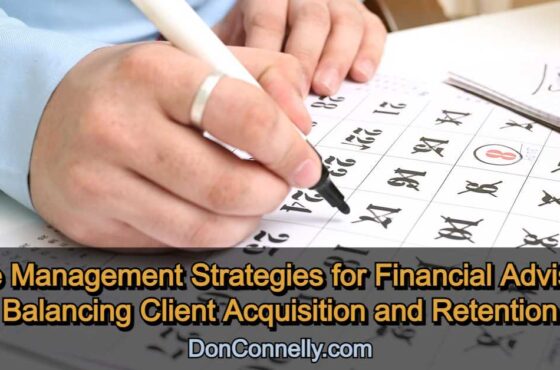For the Sake of Time, Learning to Say “No” Is a Vital Skill Advisors Must Master
 Being able to maximize time to spend on high-payoff activities has long been a significant challenge for financial advisors who must wear many hats on their path to success. Advisors not in control of their time typically have less of it to spend interacting with clients and prospecting for new clients and other activities essential to the growth of their practice.
Being able to maximize time to spend on high-payoff activities has long been a significant challenge for financial advisors who must wear many hats on their path to success. Advisors not in control of their time typically have less of it to spend interacting with clients and prospecting for new clients and other activities essential to the growth of their practice.
To gain more control of their time, advisors can follow these steps:
- Setting clear goals,
- prioritizing and planning tasks and activities,
- delegating and outsourcing administrative tasks,
- utilizing technology to automate repetitive tasks where possible,
- blocking time and batching similar tasks together,
- creating a focused work environment to limit distractions and
- learning to say “no.”
While all these combine to create an effective strategy for controlling your time, it’s the last one—learning to say “no” that can have the most immediate and enduring impact on its own. That’s because of the number of opportunities to say it that can come up even in just one day and the difficulty people have in saying it.
If all you did was learn to say “no” when appropriate, you could get back a substantial amount of valuable time to use with more productive activities.
Saying “no” is an essential skill financial advisors must develop to master their time and avoid burnout. Here are some key situations where a well-placed “no” can have a powerful impact on your time:
#1. When to say ‘no’ to client requests
Scope creep
If a client’s requests constantly exceed the agreed-upon scope of service, gently remind them of your initial agreement and offer alternatives for addressing their needs or options for additional services at fair rates.
Non-aligned clients
If a client’s values or financial goals clash significantly with your expertise or philosophy, it’s better to decline to work with them to ensure a good fit for both parties. You can help them by referring them to a colleague or another firm more suited to their needs.
Unrealistic expectations
When a client expects quick, unrealistic returns or asks for risky investment recommendations outside their risk tolerance or investment strategy, politely explain why it’s not in their best interest and suggest alternative approaches. That could lead to referring them to a more suitable colleague or firm.
Generally, clients who are not compatible with your service offering, planning philosophy, business values, or temperament can cost you valuable time. If you find yourself having to say “no” often to a client or are generally at odds with them, you should consider delivering the ultimate “no” by declining to work with them,
#2. When to say ‘no’ to work demands
Low-value activities
Learn to identify and artfully decline tasks that don’t contribute significantly to your client value or practice growth. Delegate, automate or eliminate these tasks to free up your time.
Unprofitable services
If certain services consistently drain your time without adequate compensation, consider reevaluating their offering or raising your fees to reflect their true value.
Excessive requests
Don’t hesitate to say “no” to colleagues or team members if their requests overwhelm your workload or disrupt your planned schedule. Offer alternative solutions or suggest a different timeframe for tackling their request.
#3. When to say ‘no’ to keep your personal boundaries
After-hours work
Set clear boundaries between work and personal life. Decline requests for meetings or calls outside your designated work hours unless they are absolutely necessary.
Constant availability
Don’t feel obligated to immediately respond to emails or messages, especially outside work hours. Prioritize your well-being and schedule dedicated times to address communication.
Excessive social events
Saying “no” to industry events or networking opportunities you don’t find valuable is entirely acceptable. Focus your energy on activities that genuinely benefit your client relationships and business growth.
Saying “no” doesn’t have to be confrontational.
You can be assertive while being respectful as you explain your rationale for declining. Always try to offer alternative solutions if possible or suggest they connect with someone else on your team who may be a better fit.
Ultimately, learning to say “no” can empower you to prioritize your time, focus on high-value activities, and maintain a healthy work-life balance, which is the formula for increased productivity, improved client relationships, and a more fulfilling career in the long run.
Watch this 3-minute video to learn how our 24-step training program can help you become brilliant at the basics and take your business to the next level.
See program details and enroll today!
Available as a self-paced program (always open) or as a 12-week coaching program (open only a couple of times a year), this training will change the way you view your practice. Select your format and enroll now!



